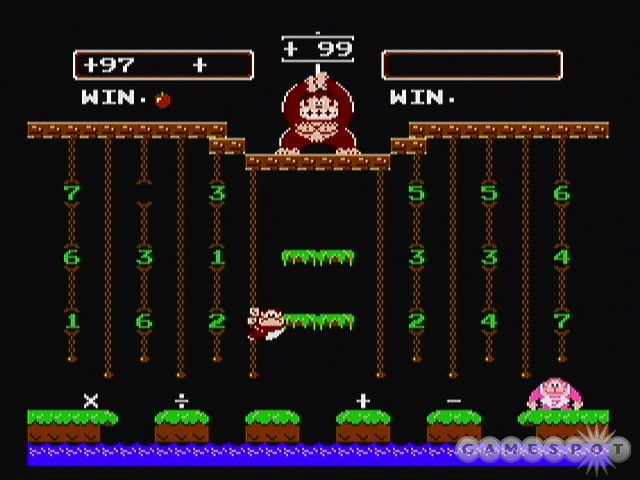Back in 1985, one of the ways companies like Nintendo lured parents into buying its machines was with the promise of educational video games that would help children practice their studies. Sure, little Johnny and Jill could spend hours jumping over goombas as Mario, but they could also just as easily spend some time sharpening their basic math skills with a game like Donkey Kong Jr. Math. That would've been fine, except that Donkey Kong Jr. Math offers less instructional value than a dollar pack of flash cards and roughly the same amount of entertainment.

Donkey Kong Jr. Math takes two of the levels from the original Donkey Kong Jr. and transforms them into hands-on math problems. In one level, two players compete to see who can match Daddy Kong's number first. The fruit and enemies on the vines have been replaced by numbers, and math symbols have been placed on the islands at the bottom of the screen. Your job is to jump between the islands and climb the vines to collect a sequence of numbers and math symbols that ultimately create the sum that DK wants. Say that the sum is 50. You could grab a "9" off a vine, collect a multiplication symbol from one of the islands, grab a "5" to make "45," and then use a plus symbol and a "5" to finally make "50." The other level in the game is a single-player practice mode in which you select a subject, such as division with remainders, or addition with regrouping, and move DK Jr. up and down the vines to key in the missing numbers.
The original Donkey Kong Jr. hasn't aged well. Its 8-bit graphics are ancient, there are only four levels, and two of the levels offer no variation at all. Donkey Kong Jr. Math uses the same engine, so it comes off as equally crude. However, it also suffers the added indignity of containing only half as many levels. Not that the number of levels really matters, given that solving math problems in this fashion is fun for approximately 30 seconds.
Worst of all, the game doesn't provide much instructional value. Sums extend out only four places, you can operate only with the numbers one through nine, and division problems are handled with remainders. Nowadays, most 8-year-olds are far beyond what Donkey Kong Jr. Math is trying to teach. As it is, you'll be able to hold a younger child's attention better with a stack of flash cards or a LeapPad learning kit than you will with a game that is this boring and lacking in encouragement.
Why Nintendo bothered to make Donkey Kong Jr. Math available for the Wii's Virtual Console is a mystery. It was a terrible game and a poor educational tool in 1985, and it's still just as devoid of merit more than twenty years later.